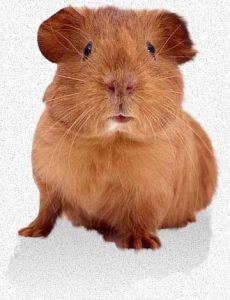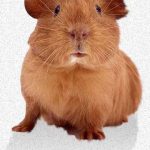 Read about reproductive problems in guinea pigs here
Read about reproductive problems in guinea pigs here
Guinea Pigs As Pets – God’s Gentlest Creatures
Ron Hines DVM PhD
I love guinea pigs. Of all the furry pets that I treat, guinea pigs are by far the gentlest. They do not have a mean bone in their body and it is hard to believe that they were once capable of existing in the wild. The Spaniards introduced guinea pigs to Europe in 1554. They obtained them from the Inca Indians of Peru who kept them for food from as early as 5000 BC.
These rodent-like animals no longer exist in the wild. They are also called cavies. Guinea pigs are very shy by nature. They are active in the daytime and occasionally at night. Guinea pigs are very vocal and this vocalization plays an important part in socialization with other pigs and humans.
Guinea pigs love company. Researchers have counted at least eleven different sounds that guinea pigs make in communicating with each other and their owners. Their social nature, temperament and low maintenance make them excellent pets.Guinea pigs are the gentlest of the pocket pets, which include mice, hamsters, rats and gerbils and so are ideal pets for responsible children. I would not purchase any living pet for a child younger than 9.
Guinea pigs love to be petted and will squeak and grunt with pleasure when they are gently handled. They will pine away and their health will suffer if they are not handled or kept with others of their kind or if they are ignored by their human owners. They are very clean. I got my first guinea pig when I was nine. We named her Mrs. Crawford, after one of my parent’s bridge partners who also had droopy jowls. Like swine, boy guinea pigs are called boars and females sows. Adult female guinea pigs weigh about a pound (450 gm) while males weight in at about a pound and a half (700 gm).
They used to come in four basic varieties, long and short hair, straight and swirled and an endless variety of colors. But now frizzy texels, extra soft silkys and teddys are also available.
With good care and proper diet, guinea pigs should live 5-7 years. A few will reach 8 years of age.
 What Guinea Pig Would Be Right For Me?
What Guinea Pig Would Be Right For Me?
If you decide to purchase two pigs, I suggest that you make them both immature females. Males are more active than females and grow up larger. They also produce more odor. If you purchase a male and a female you will have to have the male neutered or be resigned to endless litters of baby pigs and a shortened female life span. Females can become pregnant as early as two months of age, so it is quite common for them to be already pregnant when you purchase them at a pet shop. If no males are present, there is no need to spay a female. Spaying a female guinea pig is considerably more expensive than neutering a male. Find a veterinarian with extensive knowledge of “pocket pets” to do this. The anesthesia technique is quite different from that used with dogs and cats.
Not all pet shop employees can tell an immature female guinea pig from an immature male guinea pig. My client’s first suspicions are often when babies arrive. So have an experienced employee sex the pigs for you. Better still, find a local breeder and obtain your pig there.
 What Sort Of House Will My Guinea Pig Need?
What Sort Of House Will My Guinea Pig Need?
Like all animals that are regularly eaten in the wild, guinea pigs are very uncomfortable with people and other pets hovering over them. Provide them with containers or objects that they can get into and remain out of sight if they wish.
Guinea pigs left free to roam the house eventually get into trouble. So keep them in a cage or pen. Powder-coated cages for guinea pigs are available at most pet stores. Most are designed for one, not two, guinea pigs and many are too small. I like to have 4 – 6 square feet of floor space for one or two pigs – considerably more than the sad 10″ x 10″ x 7″ that American federal law requires. (ask me for guineapigcare-AnimalWelfareAct.pdf) Put a small wooden or cardboard box in the cage for the guinea pig to hide in. It is important that the cage not have a raised floor grid. With time, these grids cause the guinea pig’s feet to become sore and inflamed.
My guinea pigs never jumped, (although readers of this article report theirs do). In any case, no cage lid is required if the walls are at least 18 inches high. I do not like to keep guinea pigs in glass aquariums – they become too humid. Keep their cage in an area where temperatures range between 65 – 75 F (18-25 C). Guinea pigs handle cold quite well but they are very susceptible to heat stroke. Allow them plenty of supervised exercise time outside of their cage. Be careful, particularly if children are involved, the most common accidents that occur are being stepped on and falling off tables.
Be careful of toxic plants, electric wires, etc. – guinea pigs love to nibble and they sample most everything once. Do not trust your cats and dogs until your are certain they will not hurt the pig. Pick up guinea pigs with both hands; one round their shoulders and the other supporting their hindquarters. Be very gentle with pregnant females and youngsters.
 What Sort Of Bedding Should I Use In My Guinea Pig’s Pen?
What Sort Of Bedding Should I Use In My Guinea Pig’s Pen?
My favorite bedding is large flaked pine wood shavings. Several guinea pig breeders take exception to this and reported cases of liver damage associated with pine bedding. If you use pine flakes, try to select one with low aroma. These are from low-resin pine species that do not contain large amounts of aromatic organic compounds. They can be purchased in large bales at feed stores. Since all bedding is a cast-off of some other industry, examine it closely for things that shouldn’t be there.
I try not to purchase bedding that is dusty or moldy. Hard wood chips are also fine for guinea pigs but they are messier. Shredded newspaper with soy inks also make excellent bedding. I do not use cedar shaving because of their strong aroma but I do not actually recall a case where cedar’s aroma was linked to a health problem. Bedding should never be allowed to get damp. Change the bedding once or twice a week.
 What Should I Feed My Guinea Pig?
What Should I Feed My Guinea Pig?
Like humans, but unlike dogs and cats, guinea pigs need a daily source of vitamin C or ascorbic acid. A lack of vitamin C causes a disease called scurvy. Scurvy in guinea pigs causes eye infections, hair loss and pneumonia. All guinea pig pellets are fortified with vitamin C. But after a few months of storage much of this vitamin is lost. That is why I suggest that vitamin C be added to their diet. Guinea pigs need about 25-35 mg of vitamin C a day. You can break up 250 – 500 mg ascorbic acid tablets and sprinkle a portion on their food daily.
Guinea pigs can be maintained on commercial guinea pig pellets alone. But I like to also feed mine timothy hay, kale, spinach, collard and turnip greens. Iceberg lettuce is valueless but romaine lettuce – especially the outer leaves is a good source of nutrients. You can pick and wash dandelion from your yard as well. Alfalfa hay and cubes can be feed sparingly if other hay is also fed. Many sources of alfalfa are too rich to be a major component of guinea pig diets. Fruits, starchy vegetables and sweet items are best not fed because they can destroy the normal intestinal flora or bacteria on which these pets rely.
I suggest that guinea pig chow make up one half to two thirds of your pig’s diet. Purchase only name brand guinea pig pellets and be sure the sacs are fresh. An excellent brand is Mazuri® (Buy the “Small Pack” Guinea Pig Diet 5E11 unless you have quite a few guinea pigs) . Large retail outlets tend to turn over their stocks of feed more rapidly than smaller stores so purchase your pellets at big outlets. If you purchase more than can be used in two months keep it in the refrigerator or freezer. To find a good hay source in your area – link up with some experienced guinea pig breeders. If rabbit and chinchilla breeders are happy with a hay source, you will be too. But remember that every field and every cut produces a different hay.
Food And Water Containers:
I use heavy lead-free ceramic food dishes that the pigs can not knock over. Water can be provided in bowls but quickly get soiled with loose bedding and food. Water bottles with stainless steel ball bearing sipper tubes are much better. Guinea pigs drink a lot of water and love to run the water out of the bottles. That is why the sipper tube must have a metal ball in its spout.
Gnaw Items:
Some people say that guinea pigs are rodents and some say they are not. Like rodents, guinea pig’s teeth are constantly growing. They need safe wooden or bone objects in their cage on which to wear their teeth down or the teeth will overgrow, making it very difficult for them to eat. Read more about that here.
Breeding Your Guinea Pigs:
Guinea pigs are rather easy to sex. If you pinch or squeeze the genital area the penis will extrude in young males. Adult males are quite obviously male. When I kept cavies, I was taught that female guinea pigs are fertile at as young as two months of age (55-70 days) ! And that males mature slightly later. My favorite pocket pet husbandry book The UFAW Handbook also gives the same ages for puberty (fertility). You can read more about guinea pig pregnancy problems here.
However, a reader recently informed me that guinea pig females can become pregnant as early as three weeks of age and that males can be fertile as early as four weeks of age. I never separated males from females at so young an age and I have never observed pregnancies occurring so young but apparently this might happen. So play it safe and separate the males babies from the female babies as soon as you can determine their sex. Female guinea pigs have estrus or fertile periods just after giving birth and periodically throughout the year. The length of their estrus cycle is sixteen and one-half days. They are fertile for 6-11 hours, usually beginning in the evening. They come into heat again shortly after birthing. Although female pigs are fertile at two months of age or earlier, they should not be breed until they are 4-5 month old and weigh a little over a pound. The male used should be about double her age to insure potency.
A bigger problem is breeding female guinea pigs for the first time when they are too old. At 7-12 month of age the female’s pelvic bones fuse, making natural delivery next to impossible. So guinea pigs of that age that are having a first time litter often need the little piglets delivered by cesarean section (dystocia). Baby pigs arrive after a pregnancy of 60-70 days. They are precocious, that is, they arrive fully developed. Babies suckle their mothers for about three weeks (180 gm) and then are able to eat the same foods as their parents. Litter size ranges between one and eight. Be sure to handle the babies often at this age so that they become tame.
 What Are The Common Disease And Health Problems That Affect Guinea Pigs?
What Are The Common Disease And Health Problems That Affect Guinea Pigs?
The most common illnesses I see in guinea pigs are pneumonia and hair loss associated with malnutrition (lack of vitamin C and other nutrients). The second most common problem is the debility of old age.The third most common problems are intestinal issues that produce straining and diarrhea. That can be due to feeding a diet too rich in sugar, fruit, starches or carbohydrates.
The most common disease I find is newly purchased pigs at breeders and pet stores is pasteurellosis. Pasteurellosis is caused by a bacterium, Pasteurella multocida, that is present in some breeding colonies. It causes respiratory and eye infections as well as abscesses. The next most common diseases are often streptococcal bacterial infections. . Although pasteurella and streptococcus can be cured with antibiotics these antibiotics can be fatal to the guinea pig. Guinea pigs are notorious about handing antibiotics poorly. The problem is that these antibiotics also kill the “good” bacteria that reside in the pig’s cecum and that are essential to proper digestion. If these bacteria are killed, the guinea pig will soon succumb to toxic products that accumulate in the intestine.
Keep your guinea pigs toenails clipped short every month with human toenail clippers. If you should accidentally cut one nail too short, push the nail firmly into a moistened bar of Ivory soap to stop the bleeding. Long haired varieties may need occasional brushing. Use a slicker comb designed for Persian cats.

 How Can I Choose A Guinea Pig That Is Likely To be Healthy?
How Can I Choose A Guinea Pig That Is Likely To be Healthy?
When you purchase your guinea pig, be sure it appears healthy. Its eyes should be bright and clean, never crusty or lacking luster.
Check it’s nose, eyes, ears, and rear end to be sure it is free from any crusts, discharges, redness or inflammation. . The guinea pig should be alert and active, and plump. Its coat should be full and lustrous. Check its skin for flakes, and redness, and check carefully for parasites such as lice. When you pick up the guinea pig it may be quite skittish and fearful. It should quickly relax in your hands as you stroke it. Don’t purchase a guinea pig that is too calm or too skittish



 What Guinea Pig Would Be Right For Me?
What Guinea Pig Would Be Right For Me? What Sort Of House Will My Guinea Pig Need?
What Sort Of House Will My Guinea Pig Need? What Sort Of Bedding Should I Use In My Guinea Pig’s Pen?
What Sort Of Bedding Should I Use In My Guinea Pig’s Pen? What Should I Feed My Guinea Pig?
What Should I Feed My Guinea Pig? What Are The Common Disease And Health Problems That Affect Guinea Pigs?
What Are The Common Disease And Health Problems That Affect Guinea Pigs?
 How Can I Choose A Guinea Pig That Is Likely To be Healthy?
How Can I Choose A Guinea Pig That Is Likely To be Healthy?